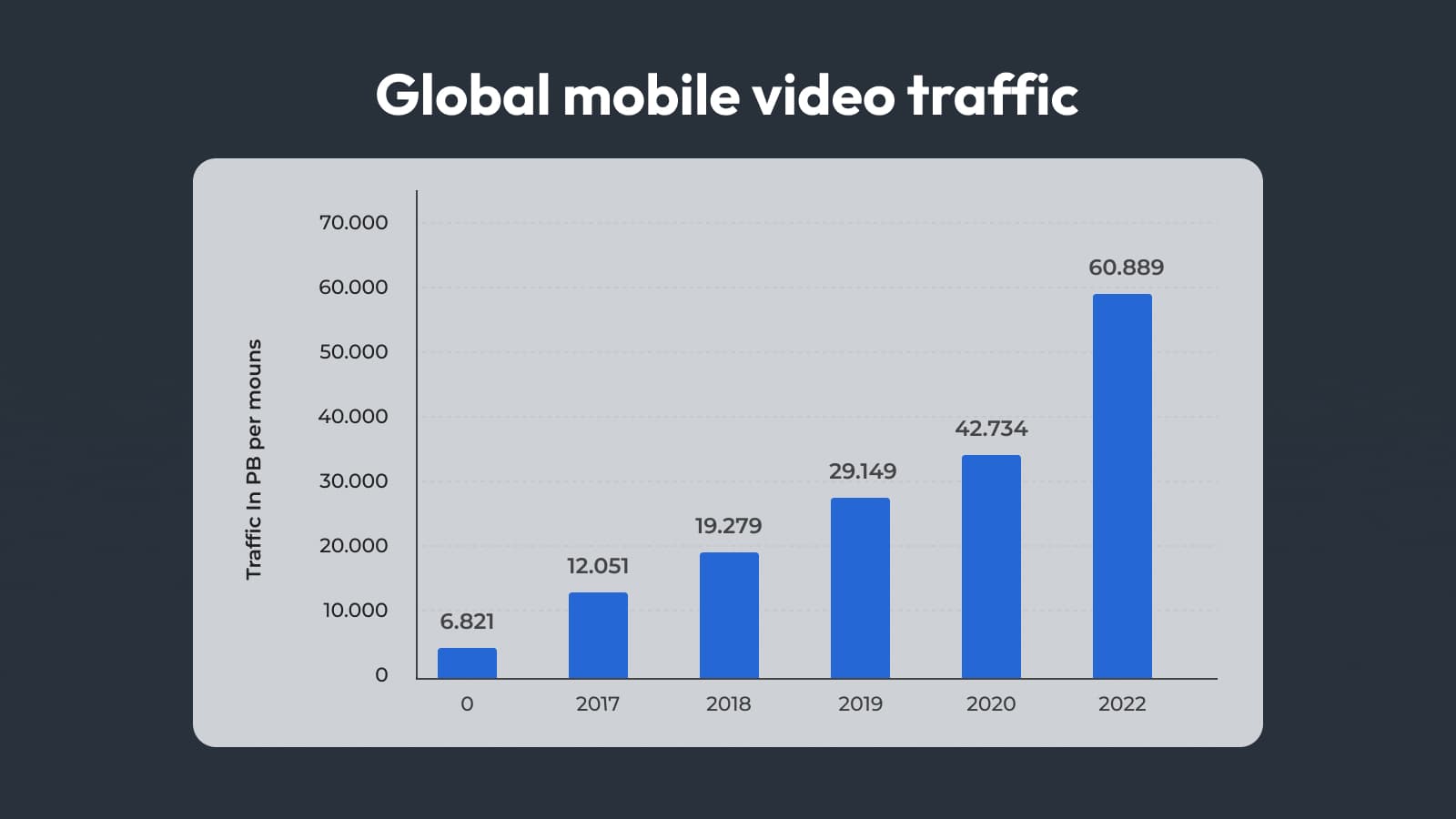The surge in the popularity of video editing applications has empowered individuals to effortlessly create polished videos within the comfort of their homes. These applications unlock the creative potential of users, allowing them to produce unique content for various platforms, particularly social media.
So, how to make a video editing app? Developing a successful and attractive video editing app is a challenging endeavor that requires the integration of numerous crucial features. This article will outline the essential components needed for a video editing application and provide an estimate of the associated development costs.
Video Editing Apps Classification
The increasing prevalence of smartphones and the growth of social media platforms have contributed to the rising popularity of video editing apps. These apps cater to a diverse audience, from beginners seeking to enhance home videos to professional videographers and content creators. Various types of video editing apps cater to different editing needs:
Basic apps
These video editing applications boast user-friendly interfaces, making them ideal for quick edits tailored for social media or personal use. Their features encompass essential functions such as trimming, cutting, and merging video clips. Noteworthy examples of such user-friendly applications include iMovie for iOS, Movie Maker for Windows, and Adobe Premiere Rush.
Advanced Editing Apps
Designed for users seeking enhanced control and a diverse array of editing capabilities, these advanced video editing applications boast features such as multi-track editing, transitions, special effects, and color correction. Tailored to the needs of content creators, YouTubers, and individuals aspiring to produce professional-quality videos, notable examples include Adobe Premiere Pro, Final Cut Pro (macOS), and DaVinci Resolve.
Mobile Video Editing Apps
Tailored for video editing on smartphones and tablets, these applications, such as Kinemaster, InShot, and Adobe Premiere Rush, provide users with touch-based editing tools and efficient export options. Primarily favored for the creation of concise videos tailored for platforms like Instagram and TikTok, these apps offer a user-friendly experience, enabling quick and hassle-free video editing directly from mobile devices.
Social Media Video Apps
Certain social media platforms offer dedicated in-app video editing tools tailored to meet the specific requirements and limitations of the platform. Users utilizing these features can enhance their videos by adding filters, stickers, captions, and music directly within the platform. Notable examples include Instagram’s in-app video editor and TikTok’s video creation tools.
AI-Powered Video Editing Apps
Leveraging artificial intelligence, video editing applications utilize advanced technologies to automate diverse tasks, ranging from color correction and object removal to voice/text-to-speech generation. This integration of AI proves particularly beneficial in saving time on repetitive editing tasks. Notable examples of such AI-powered video editing apps include Lumen5, Magisto, and Runway ML.
Specialized Video Editing Apps
Specialized video editing apps cater to specific niches or industries, including vlogging, gaming, or 3D modeling, offering features meticulously tailored to the unique needs of their target audience. Examples of such apps include OBS Studio, designed for live streaming and gaming, and HitFilm Express, specializing in visual effects and compositing.
Collaborative Video Editing Apps
Created with collaborative efforts in mind, these video editing applications are specifically designed to facilitate teamwork, enabling multiple users to seamlessly collaborate on a video project in real-time. These platforms often incorporate cloud-based storage solutions along with features that support simultaneous collaboration.
Notable examples of such collaborative video editing apps include Frame.io, Wipster, and Adobe Premiere Pro, which includes dedicated collaborative features for enhanced team productivity.
Choosing a video editing app depends on factors such as expertise level, platform, and project requirements. Whether you’re a novice, a social media enthusiast, or a professional videographer, there’s a video editing app to meet your needs and bring your creative vision to life.
What to Keep in Mind while Developing Video Editing App
No matter if you decided to create a video editing solution or to build live video streaming app, it all involves critical decision-making. To create a reliable product that resonates with the target audience and avoids becoming obsolete, it is crucial to structure and refine the app idea. Key considerations include:
Target Audience definition
Focus on the target audience, their pain points and interests. Research and analyze different consumer groups to define who would benefit most from the app competitors to and identify opportunities for improvement.
Competitor Analysis
Evaluate competitors in the market and assess their features or shortcomings. Also, gain insights into differentiation opportunities and avoid pitfalls observed in rival apps.
Analytics System
Set up an efficient analytics system to track user behavior. Don’t forget to use data to enhance the app’s popularity and success. Taking the time to address these considerations before starting the development process provides clarity and increases the chances of profitability upon launch.
Choice of monetization model
Before coming right to development, define how you’ll generate revenue. Here are key monetization approaches you can consider:
- Freemium model: Here, the basic product version is offered for free. However to access more extensive functionality, your users will have to commit to a subscription.
- In-app advertising: This model implies displaying digital ads within the app. Advertisers pay you to showcase their ads.
- Subscription model: This models imply that users pay annual or monthly fee to access your product or service.
- Paymium model: This model is quite similar to freemium, however, the main difference is that in a freemium model, the basic version is free with optional paid upgrades, while in a paymium model, users pay upfront for access to the core product or service.

Technological Challenges in Video Editing App Development
Developing a video editing app presents unique technological challenges, including:
- Real-Time Rendering and Processing: Ensuring smooth and efficient performance for tasks like video playback and effects application.
- Compatibility Across Devices and Platforms: Ensuring seamless functionality across diverse devices, operating systems, and screen sizes.
- Multimedia Integration: Managing the integration of video, audio, images, and text seamlessly.
- Video Compression and Formats: Handling various video formats, codecs, and optimizing for high-resolution standards.
- User Interface and User Experience: Crafting an intuitive and user-friendly interface for a positive user experience.
- Real-Time Collaboration: Implementing robust backend infrastructure for simultaneous collaboration on video projects.
- Data Handling and Storage: Efficiently managing large media files with cloud integration and backup solutions.
- Security and Privacy: Developing robust security measures to protect user data, especially in cloud-based apps.
- AI and Machine Learning Integration: Effectively integrating and training AI models for tasks like scene detection and content suggestions.
- Testing and Quality Assurance: Conducting extensive testing under various conditions to ensure reliability.
Developing a video editing app requires a multidisciplinary approach and a deep understanding of multimedia processing and real-time rendering. Balancing hardware optimization, software engineering, and user experience design is essential to meet these challenges and deliver a high-quality application.
Cost Considerations in Video Editing App Development
The development cost of a video editing app depends on various factors, like the number of features you plan to incorporate or integration you would like to include. However key features imperative for an efficient video editing app encompass fundamental editing tools like video trimming, cropping, and clip merging.
They also extend to advanced capabilities such as integration with AI and machine learning, alongside rigorous testing and quality assurance. The development costs for these functionalities can vary, spanning from $35,000 to $400,000, contingent upon the project’s intricacy. However, utilizing cross-platform flutter app development services may help you cut costs by up to 30% due to the less time and money needed to create a single unified solution for both iOS and Android.
Clients seeking feature-rich apps tailored to their specific needs may incur additional costs. Technical challenges, especially on specific platforms, can contribute to increased expenses. Therefore, thorough research is crucial to identify potential technical issues beforehand and choose the right platform to minimize or avoid future costs.
In conclusion, creating a successful video editing app goes beyond coding; it requires meticulous planning, thoughtful design, and a deep understanding of essential features for a delightful user experience. Additionally, acknowledging the financial commitment associated with app development is crucial for a well-informed development journey.




